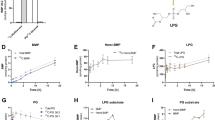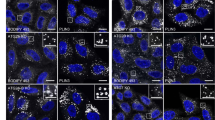Abstract
Synthesis and sorting of lipids are essential for membrane biogenesis; however, the mechanisms underlying the transport of membrane lipids remain little understood. Ceramide is synthesized at the endoplasmic reticulum and translocated to the Golgi compartment for conversion to sphingomyelin. The main pathway of ceramide transport to the Golgi is genetically impaired in a mammalian mutant cell line, LY-A. Here we identify CERT as the factor defective in LY-A cells. CERT, which is identical to a splicing variant of Goodpasture antigen-binding protein, is a cytoplasmic protein with a phosphatidylinositol-4-monophosphate-binding (PtdIns4P) domain and a putative domain for catalysing lipid transfer. In vitro assays show that this lipid-transfer-catalysing domain specifically extracts ceramide from phospholipid bilayers. CERT expressed in LY-A cells has an amino acid substitution that destroys its PtdIns4P-binding activity, thereby impairing its Golgi-_targeting function. We conclude that CERT mediates the intracellular trafficking of ceramide in a non-vesicular manner.
This is a preview of subscription content, access via your institution
Access options
Subscribe to this journal
Receive 51 print issues and online access
We are sorry, but there is no personal subscription option available for your country.
Buy this article
- Purchase on SpringerLink
- Instant access to full article PDF
Prices may be subject to local taxes which are calculated during checkout






Similar content being viewed by others
References
Chen, Y. A. & Scheller, R. H. SNARE-mediated membrane fusion. Nature Rev. Mol. Cell Biol. 2, 98–106 (2001)
Zerial, M. & McBride, H. Rab proteins as membrane organizers. Nature Rev. Mol. Cell Biol. 2, 107–117 (2001)
Voelker, D. R. in Biochemistry of Lipids, Lipoproteins and Membranes 4th edn (eds Vance, D. E. & Vance, J.) 449–482 (Elsevier, Amsterdam, 2002)
van Meer, G. & Holthuis, J. C. M. Sphingolipid transport in eukaryotic cells. Biochim. Biophys. Acta 1486, 145–170 (2000)
Maxfield, F. R. & Wüstner, D. Intracellular cholesterol transport. J. Clin. Invest. 110, 891–898 (2002)
Hanada, K. et al. Mammalian cell mutants resistant to a sphingomyelin-directed cytolysin. Genetic and biochemical evidence for complex formation of the LCB1 protein with the LCB2 protein for serine palmitoyltransferase. J. Biol. Chem. 273, 33787–33794 (1998)
Fukasawa, M., Nishijima, M. & Hanada, K. Genetic evidence for ATP-dependent endoplasmic reticulum-to-Golgi apparatus trafficking of ceramide for sphingomyelin synthesis in Chinese hamster ovary cells. J. Cell Biol. 144, 673–685 (1999)
Funakoshi, T., Yasuda, S., Fukasawa, M., Nishijima, M. & Hanada, K. Reconstitution of ATP- and cytosol-dependent transport of de novo synthesized ceramide to the site of sphingomyelin synthesis in semi-intact cells. J. Biol. Chem. 275, 29938–29945 (2000)
Yasuda, S. et al. A novel inhibitor of ceramide trafficking from the endoplasmic reticulum to the site of sphingomyelin synthesis. J. Biol. Chem. 276, 43994–44002 (2001)
Ohvo-Rekilä, H., Ramstedt, B., Leppimäki, P. & Slotte, J. P. Cholesterol interactions with phospholipids in membranes. Prog. Lipid Res. 41, 66–97 (2002)
Fukasawa, M., Nishijima, M., Itabe, H., Takano, T. & Hanada, K. Reduction of sphingomyelin level without accumulation of ceramide in Chinese hamster ovary cells affects detergent-resistant membrane domains and enhances cellular cholesterol efflux to methyl-β-cyclodextrin. J. Biol. Chem. 275, 34028–34034 (2000)
Raya, A., Revert, F., Navarro, S. & Saus, J. Characterization of a novel type of serine/threonine kinase that specifically phosphorylates the human goodpasture antigen. J. Biol. Chem. 274, 12642–12649 (1999)
Raya, A. et al. Goodpasture antigen-binding protein, the kinase that phosphorylates the goodpasture antigen, is an alternatively spliced variant implicated in autoimmune pathogenesis. J. Biol. Chem. 275, 40392–40399 (2000)
Pagano, R. E., Martin, O. C., Kang, H. C. & Haugland, R. P. A novel fluorescent ceramide analogue for studying membrane traffic in animal cells: Accumulation at the Golgi apparatus results in altered spectral properties of the sphingolipid precursor. J. Cell Biol. 113, 1267–1279 (1991)
Ponting, C. P. & Aravind, L. START: a lipid-binding domain in StAR, HD-ZIP and signalling proteins. Trends Biochem. Sci. 24, 130–132 (1999)
Levine, T. P. & Munro, S. _targeting of Golgi-specific pleckstrin homology domains involves both PtdIns 4-kinase-dependent and -independent components. Curr. Biol. 12, 695–704 (2002)
Kallen, C. B. et al. Steroidogenic acute regulatory protein (StAR) is a sterol transfer protein. J. Biol. Chem. 273, 26285–26288 (1998)
Tsujishita, Y. & Hurley, J. H. Structure and lipid transport mechanism of a StAR-related domain. Nature Struct. Biol. 7, 408–414 (2000)
Akeroyd, R., Moonen, P., Westerman, J., Puyk, W. C. & Wirtz, K. W. The complete primary structure of the phosphatidylcholine-transfer protein from bovine liver. Isolation and characterization of the cyanogen bromide peptides. Eur. J. Biochem. 114, 385–391 (1981)
Simon, C. G. Jr, Holloway, P. W. & Gear, A. R. Exchange of C16-ceramide between phospholipid vesicles. Biochemistry 38, 14676–14682 (1999)
Dowler, S. et al. Identification of pleckstrin-homology-domain-containing proteins with novel phosphoinositide-binding specificities. Biochem. J. 351, 19–31 (2000)
Nakano, A. & Muramatsu, M. A novel GTP-binding protein, Sar1p, is involved in transport from the endoplasmic reticulum to the Golgi apparatus. J. Cell Biol. 109, 2677–2691 (1989)
Kuge, O. et al. Sar1 promotes vesicle budding from the endoplasmic reticulum but not Golgi compartments. J. Cell Biol. 125, 51–65 (1994)
De Matteis, M., Godi, A. & Corda, D. Phosphoinositides and the Golgi complex. Curr. Opin. Cell Biol. 14, 434–447 (2002)
Wang, Y. J. et al. Phosphatidylinositol 4 phosphate regulates _targeting of clathrin adaptor AP-1 complexes to the Golgi. Cell 114, 299–310 (2003)
Loewen, C. J., Roy, A. & Levine, T. P. A conserved ER _targeting motif in three families of lipid binding proteins and in Opi1p binds VAP. EMBO J. 22, 2025–2035 (2003)
Ladinsky, M. S., Mastronarde, D. N., McIntosh, J. R., Howell, K. E. & Staehelin, L. A. Golgi structure in three dimensions: functional insights from the normal rat kidney cell. J. Cell Biol. 144, 1135–1149 (1999)
Viani, P. et al. Ceramide in nitric oxide inhibition of glioma cell growth. Evidence for the involvement of ceramide traffic. J. Biol. Chem. 278, 9592–9601 (2003)
Ardail, D. et al. The mitochondria-associated endoplasmic-reticulum subcompartment (MAM fraction) of rat liver contains highly active sphingolipid-specific glycosyltransferases. Biochem. J. 371, 1013–1019 (2003)
Venkataraman, K. et al. Upstream of growth and differentiation factor 1 (uog1), a mammalian homolog of the yeast longevity assurance gene 1 (LAG1), regulates N-stearoyl-sphinganine (C18-(dihydro)ceramide) synthesis in a fumonisin B1-independent manner in mammalian cells. J. Biol. Chem. 277, 35642–35649 (2002)
Funato, K. & Riezman, H. Vesicular and nonvesicular transport of ceramide from ER to the Golgi apparatus in yeast. J. Cell Biol. 155, 949–959 (2001)
Soccio, R. E. & Breslow, J. L. StAR-related lipid transfer (START) proteins: mediators of intracellular lipid metabolism. J. Biol. Chem. 278, 22183–22186 (2003)
Mathias, S., Pena, L. A. & Kolesnick, R. N. Signal transduction of stress via ceramide. Biochem. J. 335, 465–480 (1998)
Hannun, Y. A. & Luberto, C. Ceramide in the eukaryotic stress response. Trends Cell Biol. 10, 73–80 (2000)
Albritton, L. M., Tseng, L., Scadden, D. & Cunningham, J. M. A putative murine ecotropic retrovirus receptor gene encodes a multiple membrane-spanning protein and confers susceptibility to virus infection. Cell 57, 659–666 (1989)
Morita, S., Kojima, T. & Kitamura, T. Plat-E: an efficient and stable system for transient packaging of retroviruses. Gene Ther. 7, 1063–1066 (2000)
Patki, V. et al. Identification of an early endosomal protein regulated by phosphatidylinositol 3-kinase. Proc. Natl Acad. Sci. USA 94, 7326–7330 (1997)
Kasper, A. M. & Helmkamp, G. M. Jr Intermembrane phospholipid fluxes catalyzed by bovine brain phospholipid exchange protein. Biochim. Biophys. Acta 664, 22–32 (1981)
Yasuda, S., Nishijima, M. & Hanada, K. Localization, topology, and function of the LCB1 subunit of serine palmitoyltransferase in mammalian cells. J. Biol. Chem. 278, 4176–4183 (2003)
Banerjee, A., Gregori, L., Xu, Y. & Chau, V. The bacterially expressed yeast CDC34 gene product can undergo autoubiquitination to form a multiubiquitin chain-linked protein. J. Biol. Chem. 268, 5668–5675 (1993)
Acknowledgements
We thank J. Cunningham for the mCAT-1 cDNA; T. Kitamura for the Plat-E cells; O. Kuge for the 5′-RACE- and 3′-RACE-ready CHO cDNAs and the E. coli expression plasmids for CHO Sar1a and Sar1a[T39N]; and Y. Sekizawa for lysenin. This work was supported by the Ministry of Education, Culture, Sports, Science and Technology (MEXT).
Author information
Authors and Affiliations
Corresponding author
Ethics declarations
Competing interests
The authors declare that they have no competing financial interests.
Supplementary information
Rights and permissions
About this article
Cite this article
Hanada, K., Kumagai, K., Yasuda, S. et al. Molecular machinery for non-vesicular trafficking of ceramide. Nature 426, 803–809 (2003). https://doi.org/10.1038/nature02188
Received:
Accepted:
Issue Date:
DOI: https://doi.org/10.1038/nature02188
This article is cited by
-
Sphingolipids: drivers of cardiac fibrosis and atrial fibrillation
Journal of Molecular Medicine (2024)
-
Ceramide releases exosomes with a specific miRNA signature for cell differentiation
Scientific Reports (2023)
-
Long chain ceramides raise the main phase transition of monounsaturated phospholipids to physiological temperature
Scientific Reports (2022)
-
Structure-dependent absorption of atypical sphingoid long-chain bases from digestive tract into lymph
Lipids in Health and Disease (2021)
-
Sphingolipids mediate polar sorting of PIN2 through phosphoinositide consumption at the trans-Golgi network
Nature Communications (2021)



